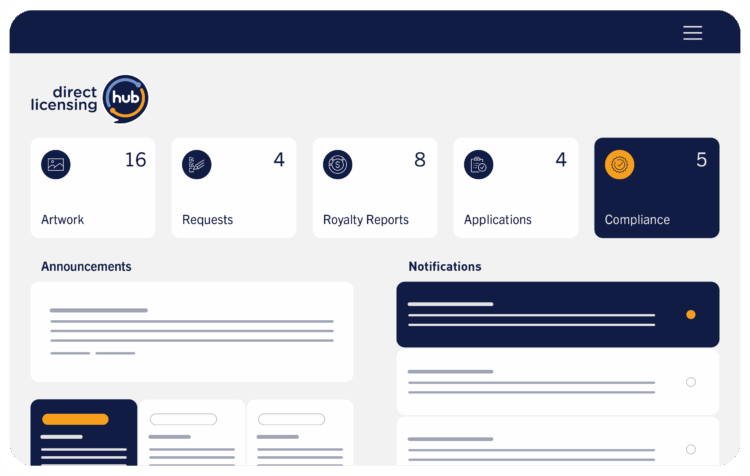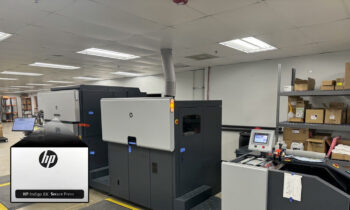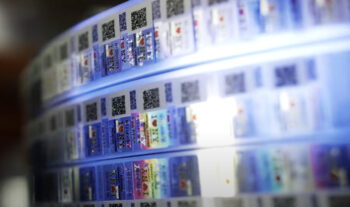JPatton’s layered security labels combine currency-grade printing, holography, and forensic codes to protect against counterfeiting. Image courtesy of JPatton.
How JPatton Has Adapted to Protect Brands From New Threats to IP
In an era when counterfeiters move at the speed of AI, brands are under constant attack. Fake merchandise, unauthorized product diversion, and digital knockoffs are eating into legitimate revenue streams and eroding consumer trust. Few companies understand this battleground better than JPatton, a pioneer in the field of brand protection.

Founded by Jim Patton in 1996 as a pioneering holographic security printer—with patents that helped set the early standard for sports licensing protection—the company has continued to innovate for over two decades. Today, JPatton combines currency-grade secure printing, holography, micro-optics, forensic codes, and AI-driven analytics into layered systems counterfeiters can’t replicate.
To explore how JPatton is preparing brands for the future, we spoke with Wes Richard, SVP of Innovations and Operations at CLC, who oversees JPatton operations. Richard explained how the company’s layered technologies, focus on trust, responsiveness, and integration with DLH are redefining brand protection in the age of AI.
Q&A with Wes Richard
TLL: JPatton has been an innovation leader in the brand protection field since Jim Patton founded the company. Can you tell me how JPatton technologies changed the game for brand protection, particularly in sports licensing?
Wes Richard: From the very beginning, JPatton has been about innovation. We started as a holographic security printer, pioneering methods to print directly on holography; an approach protected by our early patents.
That changed the game for sports licensing, giving fans a simple way to verify authenticity while protecting brands from counterfeits.
Since then, we’ve evolved well beyond holography, layering in currency-grade secure printing, micro-optics, JP Forensics, advanced analytics, and integration with platforms like the Direct Licensing Hub (DLH). It’s that layered approach that makes our labels impossible to replicate and helps licensors protect both revenue and trust.
TLL: How do your physical brand protection technologies, like 3D micro-structures, prevent counterfeiting or help detect counterfeits?
Wes Richard: A big misconception is that a single flashy feature—like a 3D lens—is enough. Others may use a couple of features, but counterfeiters often find ways to mimic those. What sets JPatton apart is layering: secure printing, holography, micro-optics, and JP Forensics working together. Replicating one feature might be possible. Replicating them all at once isn’t. That layered system is what keeps brands secure.
TLL: Could you provide a simple explanation of OVD, DOE, DOVID, and Micro Lenses?
Wes Richard: Sure, basically OVDs or Optically Variable Devices feature visual effects that shift with light and angle. DOEs, or Diffractive Optical Elements are patterns that bend light in unique ways. DOVIDs, or Diffractive Optically Variable Image Devices, feature multiple optical effects that are combined into a single, secure element. Finally, Micro Lenses are microscopic structures that create motion, depth or animation.
Each adds protection, but when layered through secure printing, they become nearly impossible to counterfeit.
TLL: Pete Reyes noted years ago that AI would transform licensing. With generative AI now mainstream, what challenges do you see?

Wes Richard: Pete was ahead of his time. He saw that AI would make counterfeiting faster and easier. Now that it’s mainstream, counterfeiters can generate realistic packaging, logos, or even full product images in hours. The challenge is that counterfeits aren’t just more convincing—they move at the speed of the internet.
TLL: How does generative AI specifically play into the creation of counterfeit goods?
Wes Richard: It accelerates the entire process. Fake artwork, brand assets, and even product renders can be generated instantly. Combine that with 3D printing or offshore production, and counterfeit goods flood online channels almost as quickly as real ones.
TLL: On the other hand, JPatton has used AI as a solution. How does AI help protect your clients?
Wes Richard: JP Forensics integrates with our secure printing process to assign every product a unique QR code, unlocking two-factor authentication and real-time AI analysis.
When consumers scan, AI analyzes the code against our data patterns. If something looks wrong, the system prompts a second step: simply holding the label up to the phone’s camera.
AI then evaluates forensic markers and confirms authenticity in real time. Behind the scenes, we capture and process data continuously, delivering instant feedback to consumers and nightly refreshed analytics to brands.
TLL: Does AI also play a role in your broader ecosystem, like the Direct Licensing Hub (DLH)?
Wes Richard: Absolutely. DLH is the backbone of licensing management, and AI is making it smarter every day.

Imagine a system that flags suspicious activity in royalty reports, connects counterfeit scan data with licensee behavior, and highlights diversion risks before they escalate. That’s the vision we’re building toward.
Earlier this year, I spoke at the CIO 100 Symposium to CIOs from across industries and around the world about how organizations execute around AI. That perspective is central to how we’re integrating AI into JPatton and DLH; not as experiments, but as core capabilities that make licensing more secure and more intelligent.
TLL: What are the greatest security threats to brands and copyright right now, and how is JPatton addressing them?
Wes Richard: The biggest threats are speed and scale.
Counterfeiters can create and distribute at levels we’ve never seen before. We address that by combining layered physical security with AI analysis. It makes counterfeiting harder on the front end, and detection smarter on the back end.
TLL: How does JPatton stay on top of such a fast-moving battleground?
Wes Richard: Innovation is in our DNA. From our earliest patents to today’s forensic markers, we’ve led with new ideas. We also have access to technologies very few companies do.
Believe it or not, there are less than a dozen secure printing presses worldwide, and some of those are owned by governments producing tax stamps.
Having one means we deliver currency-grade protection that most competitors can’t even access. That exclusivity gives our clients an advantage counterfeiters can’t touch.
TLL: How big is the threat to brands from counterfeiting? Millions? Billions?
Wes Richard: It’s not just billions; it’s trillions globally!
Counterfeiting is one of the world’s largest underground economies, hitting industries from apparel to pharmaceuticals. For some brands, counterfeit sales actually rival their real sales in certain markets. That’s why brand protection is no longer optional.

TLL: What are the advantages to brands when they adopt JPatton technologies? And what happens if they don’t?
Wes Richard: The upside is clear: Protected revenue, reduced liability, stronger consumer trust. The risk of doing nothing is bigger, and includes lost sales, reputational damage, safety risks, and erosion of long-term brand value.
Once trust is gone, it’s hard to recover. And beyond the technology, our clients know they can trust us to stand with them. We’re faster and more responsive than larger competitors, which means we can provide the support brands consistently tell us they value.
TLL: How does Direct Licensing Hub (DLH) connect with JPatton’s brand protection technologies?
Wes Richard: DLH isn’t just admin software, it’s the licensing backbone trusted by brands to manage more than 60,000

brand rights and 12,000 licensees, covering over 134 million unique right combinations.
It brings applications, contracts, royalties, artwork, supply chain disclosures, and compliance into one place.
When JPatton’s secure printing, holography, and JP Forensics integrate here, protection is embedded directly into the same system that manages the business of licensing. That creates true end-to-end protection that few can match.
TLL: How does being part of CLC and Learfield make JPatton stronger?
Wes Richard: CLC brings unmatched licensing expertise—more programs and retail sales than any competitor—and JPatton provides the technology that secures those programs. But CLC also brings significant technology leadership.
Under CLC, and as part of Learfield, we combine licensing scale, tech innovation, and brand protection into a single offering. It’s a powerful combination no one else can match.
TLL: Is there anything we’ve missed?
Wes Richard: One exciting area is our work with care labels, which are the washing instruction tags sewn into garments.
By embedding security there, we’re preparing brands for the coming era of Digital Product Passports (DPPs), where every product carries a secure digital identity for authenticity, sustainability, and recycling.
It’s about protecting brands today and preparing them for tomorrow. And here’s the truth: Counterfeiters can copy features. They can’t copy layers. That’s why brands trust JPatton.
Chief Takeaways
From its early holographic printing patents to today’s AI-driven forensic authentication, JPatton has built a legacy of innovation in brand protection. What makes the company stand out isn’t just the technology itself, but the trust it has earned.
By combining layered defenses with hands-on customer service, JPatton offers something rare in this industry: A partner that protects both your products and your peace of mind.
And the story doesn’t end with protection. Through DLH, JPatton is helping brands bring licensing and protection together in one place. For licensors, that means less complexity, more visibility, and a partner committed to staying ahead of counterfeiters.
The message for brands is clear: counterfeiting is a trillion-dollar underground economy, but it doesn’t have to be a trillion-dollar problem. With JPatton’s heritage, exclusive access to currency-grade printing, customer trust, and integration with DLH, brands get something rare in this industry; multiple layers of protection and licensing strength combined into one ecosystem. It’s a level of assurance that counterfeiters can’t touch.
